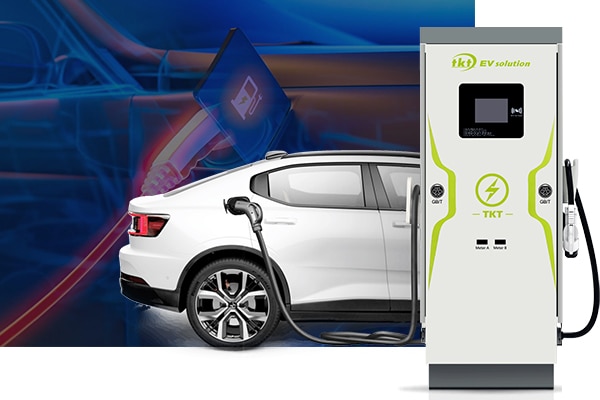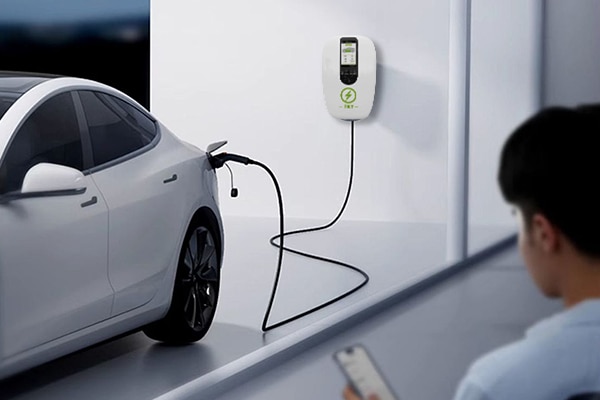Seperti kendaraan listrik (EV) mendapatkan popularitas, memahami berbagai opsi pengisian daya menjadi penting. Panduan ini akan mempelajari berbagai jenis pengisi daya EV, keluaran daya mereka, waktu pengisian daya biasa, and where you can find them. Our aim is to provide a detailed overview to help you make informed decisions about EV charging.
Types of EV Chargers
Electric vehicle charging infrastructure comprises three primary levels: Tingkat 1, Tingkat 2, and Direct Current Fast Charging (DCFC). Each level offers distinct benefits and is suitable for different situations and environments.
Tingkat 1 Mengisi daya
Tingkat 1 charging uses a standard residential 120-volt (120V) AC outlet. It is the most accessible form of EV charging, requiring no additional equipment other than the charger that typically comes with the vehicle. Namun, it is also the slowest charging option.
Keluaran Daya: Approximately 1 kW
Charging Time for BEVs: 40-50+ hours to 80% from empty
Charging Time for PHEVs: 5-6 hours to 80% from empty
Typical Locations: Rumah
Tingkat 1 charging is best suited for overnight home charging, where the vehicle can remain plugged in for an extended period.
Tingkat 2 Mengisi daya
Tingkat 2 charging utilizes 240V (residential) or 208V (commercial) electrical service. This type of charger is common in homes, tempat kerja, and public spaces. It significantly reduces charging time compared to Level 1.
Keluaran Daya: 7 kW – 19 kW
Charging Time for BEVs: 4-10 hours to 80% from empty
Charging Time for PHEVs: 1-2 hours to 80% from empty
Typical Locations: Rumah, workplace, public
Tingkat 2 chargers are ideal for daily use, providing a balance between speed and convenience. They are frequently installed in locations where vehicles are parked for several hours.
Direct Current Fast Charging (DCFC)
DCFC provides rapid charging by converting AC power to DC within the charging station, which then directly charges the vehicle’s battery. This method is typically found along major highways and in high-traffic areas to facilitate long-distance travel.
Keluaran Daya: 50 kW – 350 kW
Charging Time for BEVs: 20 minutes to 1 hour to 80% from empty
Typical Locations: Public, highway corridors
DCFC is perfect for quick stops during long trips, allowing drivers to recharge their vehicles rapidly and continue their journey.
TKT EV Solution produces DC EV fast charging stations for public charging stations. We support orders with different power levels (60/90/120/150/180/200kW).

EV Charging Standards and Regulations
In February 2023, the Federal Highway Administration (FHWA), supported by the Joint Office of Energy & Transportation, introduced new national standards for federally funded EV chargers. These standards ensure a reliable and predictable charging experience, addressing several key aspects:
Accessibility: Chargers must be easily locatable.
Interoperability: Compatibility with various vehicles and networks.
Reliability: High uptime and consistent performance.
Future-Proofing: Design to accommodate forward-looking charging capabilities.
These regulations are pivotal in standardizing the EV charging infrastructure, promoting widespread adoption, and ensuring user convenience.
Overview of EV Charger Specifications
The following table summarizes the power output, plug types, and typical charging times for different EV charger types:
| Charger Type | Connector Type | Tegangan | Typical Power Output | PHEV Charge Time | BEV Charge Time | Electric Range per Hour of Charging | Typical Locations |
| Tingkat 1 | J1772 | 120 V AC | 1 kW | 5-6 jam | 40-50 jam | 2-5 miles | Rumah |
| Tingkat 2 | J1772 | 208-240 V AC | 7 kW – 19 kW | 1-2 jam | 4-10 jam | 10-20 miles | Rumah, Workplace, Public |
| DCFC | CCS, CHAdeMO, Tesla | 400-1000 V DC | 60 kW – 350 kW | N/A | 20 menit – 1 jam | 180-240 miles | Public, Highway Corridors |
Notes on Connector Types:
J1772 Connector: Common for Level 1 and Level 2 charging in North America.
CCS Connector: Widely used for DCFC in North America and Europe.
CHAdeMO Connector: Common for Japanese-manufactured vehicles.
Tesla Connector: Proprietary to Tesla, compatible with all charging speeds including Tesla’s Superchargers.
Charging Speed Considerations:
Charging speed can vary due to several factors, termasuk:
Charger manufacturer and condition
Ambient temperature
Vehicle battery capacity and condition
Charging Strategy:
To optimize charging efficiency, especially with DCFC, it is recommended to charge only up to 80% of the battery capacity. Charging beyond this point slows significantly to protect battery health.
Kesimpulan:
Understanding the nuances of EV charging is essential for maximizing the benefits of electric vehicle ownership. By choosing the appropriate charging level and being aware of the latest standards and regulations, drivers can ensure a seamless and efficient charging experience. As the EV landscape continues to evolve, staying informed about charging technologies and best practices will be crucial for both current and prospective EV owners.
TKT’s EV charging stations provide a variety of charging methods such as automatic charging, timed charging, rationed charging, Pengisian SOC, dll.. The powerful power distribution and constant power function can reduce charging time by 20%. Powerful power distribution and constant power function can shorten the charging time by 20%. Our high-quality products and efficient performance have made us widely recognized by our customers.




